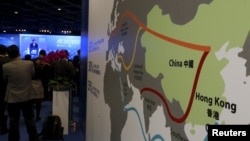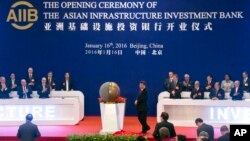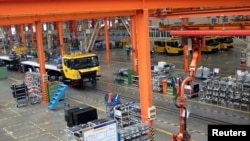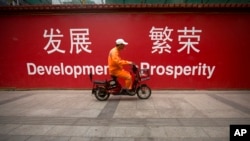China’s “Silk Road” trade and economic network, launched in 2013 by President Xi Jinping, is being seen by many as a potential "gamer changer" to boost the regional economy.
The Silk Road Economic Belt policy and 21st Century Maritime Silk Road, known as the “Belt and Road” initiative, envisions strengthening China’s business ties into Asia, through Europe and Africa.
Shamshad Akhtar, the U.N. Economic and Social Commission for Asia and the Pacific Executive Secretary, says, “Such an integrated and sustainable approach to development will boost faltering growth and trade that we are faced with today by promoting diversification and productivity while simultaneously creating new jobs...."
During the UNESCAP meeting this week in Bangkok she said the initiatives would go “a long way to transforming livelihoods across the region”.
“It aspires to connect the dynamic and vibrant Asia economic circle at one end to the European economic circle at the other,” broadening economic benefit regions presently ‘underserved’ by economic progress, Akhtar said.
After facing some initial skepticism, China is pressing ahead to include more countries in the plan.
Chinese Assistant Foreign Minister Quian Hongshen said there are more than 70 countries and international organizations seeking to participate. More than 30 countries had reached agreements with China, along with the Asian Infrastructure Investment Bank (AIIB) Beijing launched in January this year.
“The Silk Road Fund is channeling funding to specific projects at a faster pace,” Quian said. “More and more early harvest [spending] has been achieved in infrastructure connectivity, economy and trade, industrial investment, financial services, environmental protection, and people to people and cultural exchanges.”
Broadening the corridor
An initial Silk Road economic corridor linking China, Russia and Mongolia has broadened into being six corridors underway or in the planning stage.
Shen Bing, a research fellow at the National Development and Reform Commission of China, said besides ties to Eurasia, other corridors include an Asian "land bridge" with links through central Asia, as well as into Indo-China, in cooperation with Thailand and Cambodia.
Other links are between China and Pakistan and a corridor with China, Bangladesh, India and Myanmar.
“In the future we also cooperate with concerned countries to promote construction in the transportation, energy and also in the area of social development, like education, medical care, science and technology and to people to people exchange,” Shen said.
The trade and business corridors cover 4.4 billion people, 55 percent of global output and 75 percent of known energy reserves, according to U.N. economists.
The plans include "multi-modal" networks connecting road and rail routes, with sea ports, expanding fuel transportation networks through gas pipelines, regional power grids and extending ITC fiber optic links from China through central Asia and ultimately Europe.
Financing challenges
Wang Yanning, a senior adviser with the China-backed AIIB, said financing Asia's infrastructure is a key challenge, estimated at trillions of dollars.
“Whether it’s public sector or private sector there is a shared belief that this region has a lot of development potential and there are huge gaps of infrastructure [financing] to be met by joint efforts of the international community,” Wang said.
The Asian Development Bank (ADB) has estimated that more than $1 trillion a year is needed by 2020 to underpin Asia’s growth.
Economists warn that without filling gaps in critical infrastructure needs in transport, energy, telecommunications, and resource management, Asia’s growth may stall.
The AIIB is aiming at around $1 billion in initial spending as it builds up internal capacity with medium term plans to invest $10-15 billion a year. The bank is also in talks with other major international lenders.
Support policies, security needed
But analysts say China’s Belt and Road development initiative faces several challenges to ensure economic gains are sustained. U.N. economist Susan Stone said regional governments will also need to implement policies to support trade and development.
“I can’t emphasize enough the importance of the policy space in order to underpin the achievements. We hear a lot about physical infrastructure and the physical connectivity that this initiative is going to provide,” Stone said.
“It’s really important to match that with the policy and regulatory environment and in order that these wonderful physical connectivities that will be in place really have the ability to realize the potential and the development aspects across the region,” she said.
Diplomats also point to concerns over security throughout the region, as well as key maritime regions and uncertainties created by the threats from militants and other groups.
Russian Ambassador to Thailand Kirill Barsky said without security it will be difficult to achieve economic and sustainable development.
"We need to work really hard and put the stability and security in the first place. At the same time, if we do not put special [emphasis] on economic cooperation it will be difficult to strengthen the support of the efforts in the field of security," Barsky said.












